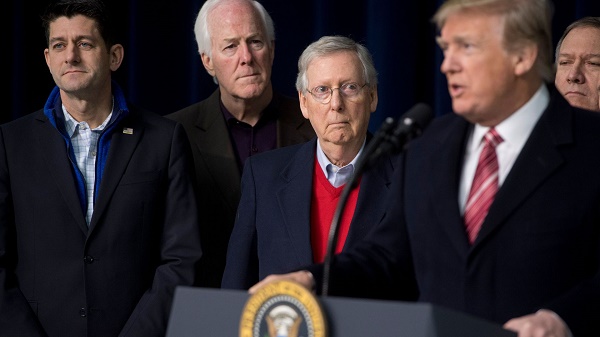Alwaght- The political division inside the US governance system under the presidency of Donald Trump is so much and unfolding further, to an extent that is almost unprecedented in the history of the country. Before Trump era, internal gaps were marked by conflicting views of Republicans and Democrats, but now the nature of differences has fully transformed into Trump vs. challengers. Trump opposition does not play a role based on their party tendencies. Rather, they criticize the president’s controversial policies and decisions from the position of defending democracy and national interests.
If we bring in the spotlight the nearly similar criticism directed against Trump by the media belonging to the two parties over the past year, we can view an unstated alliance between the major lawmakers of the Congress as a part of the nation’s power structure. The lawmakers are heavily pressing to alter Trump policies. We can refer to the jointly pushed sanctions by the Republican and Democrat congressmen against Russia in January 2017, while Trump tried to cozy up to the Russian President Vladmir Putin whom he sees a leader he can get along with for the best interests of the US. Also, considerable move is a law passed in January this year prohibiting Trump from pullout of the North Atlantic Treaty Organization, or the recent bill rebuking Trump’s withdrawal plan from Syria and Afghanistan. Despite the Senate's decision against Trump plan, Joseph Votel, the commander of the US forces in West Asia, told of the pullout of the US troops and military facilities from Syria “in weeks.”
What is causing such a broad gap inside American politics?
Apparently, part of the problem should be attributed to a conflict of views between Trump and his critics about how the US interests in the Syrian war should be pursued. Trump in early January called Syria “sand and death” that is not worth staying in further or spending more cash on. Of course, Trump’s look at Syria is totally profit-minded. He more than once bashed his predecessors whose “terrible decisions” made Washington spend $7 trillion in the region. He said this money was returning as he continues to give the American policy in the region key changes, however.
Since presidential campaigns, Trump insisted that the US should cut the military spending to protect its allies, or get cash for the protection offered.
On the other hand, the Syrian government, backed by its powerful allies Russia, Iran, and Lebanese Hezbollah, has retaken vast tracts of land from the foreign-backed terrorist groups and the calm is returning to the country after over eight years of devastating war. This situation risks a direct confrontation between American forces and Russians now that there is no major pretext for the US to stay there. Trump thinks that just because the US Arab and Kurdish allies ask Washington to keep its forces in the war-hit country does not mean the White House should do so, which is highly costly and may bring the US to blows with Damascus allies Moscow and Tehran, and even Ankara as an anti-Kurdish actor.
Furthermore, Trump is yet to realize a set of his campaign-time promises such as building a border wall with Mexico, denuclearizing North Korea, imposing a new nuclear deal on Iran, and bringing China to knees in a fierce trade war and geological competition. So, he needs to press for materialization of them a year before the race for the 2020 presidential election kicks off. Getting the forces out of Syria and focus on East Asia and mainly China is part of this effort.
But Trump move's detractors find the exit playing into the hands of Russia. They argue that leaving Syria is a privilege granted to Moscow and will allow the Syrian arena for an unchallenged play of President Bashar al-Assad of Syria allies who will in the future seize the initiative to their own favor in the regional developments. Another reason Trump critics lash out at him for Syria decision is the wish to protect the interests of Washington’s regional allies. For them, this alliance in the region is crucial to preserve the US global hegemony. They accuse Trump of closing eyes to the national interests in Syria pullout case.
But in addition to the clash of views on the impacts of the US withdrawal on the national interests, there is essential opposition to Trump’s decision which means a structural polarity is in the making inside the American community. The change of the nature of the confrontation inside the country, as it was said, is a big sign of this development.
The root of Trump rise rests in a gradual victory of a kind of nationalistic populism over the liberal democratic ideology after the 2008 economic recession in the Western world. This transformation is not only observable by Trump rise but by today’s political atmosphere of the European nations.
Trump’s rightist agenda against migration, strengthening the nationalism, and moving to unload the heavy foreign policy costs from the American taxpayers were a populist adjustment with the new situation. By calling the politicians and media the “enemies of people” and calling for a shakeup inside White House, Trump, indeed responded to the American nation's frustration with previous government's policies.
This makes Trump determined to ignore the assessments of the intelligence agencies and media experts about the future of Syria developments after US forces' pullout in favor of saving his own supporters in the next election, something facing a unified response of the bipartisan advocates of traditional US policy in the world.



























